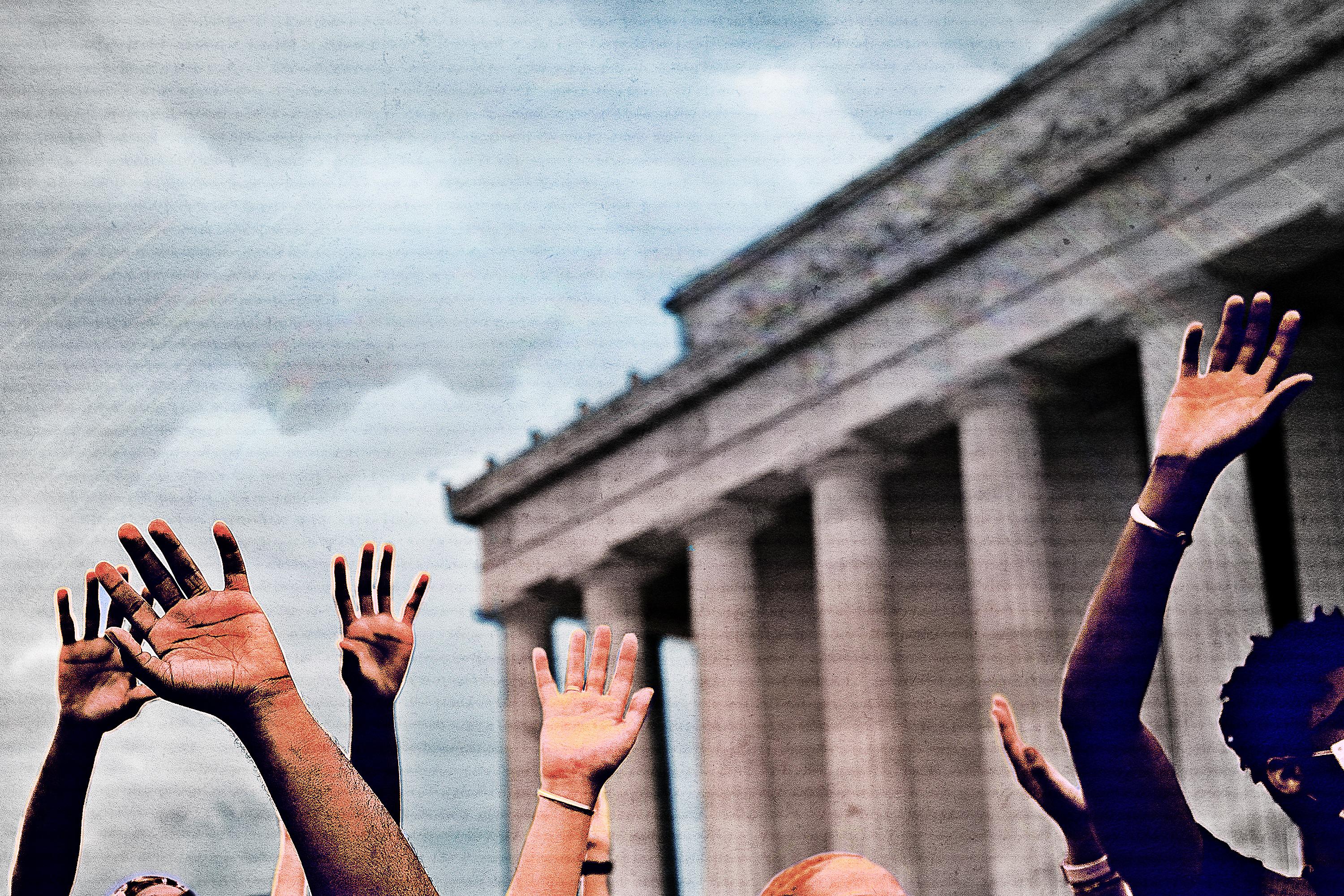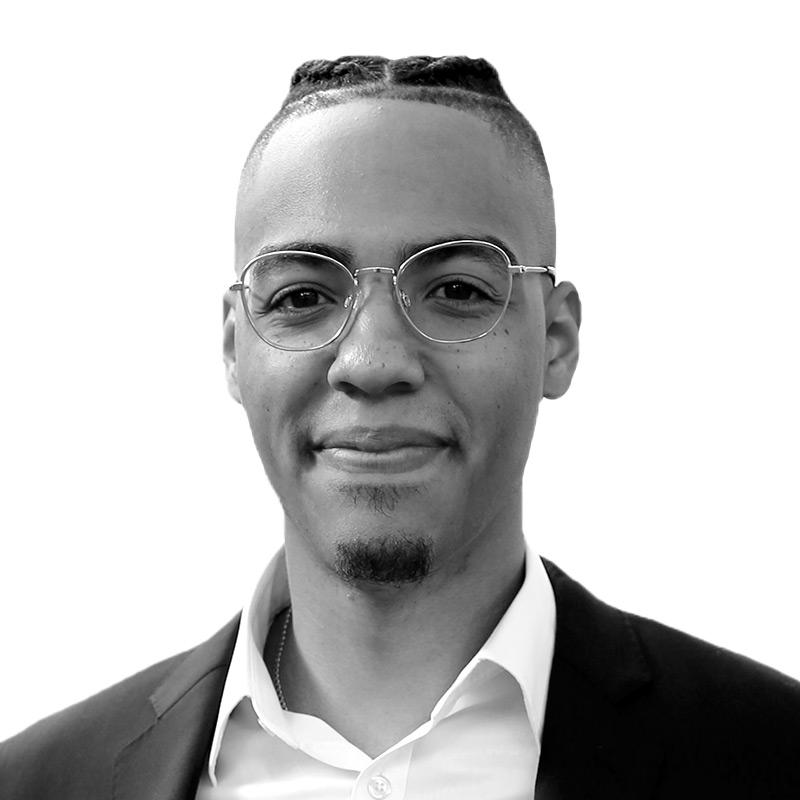Scenes of Protest and the Demand for Sustained Change in the Nation’s Capital
How demonstrations against systemic racial injustice and police brutality are resonating in Washington, D.C.
A few hundred feet from the White House, at the intersection of 16th and H Street, a man with a red bandanna climbed atop a traffic light to give an impromptu speech to a crowd of protesters. It was 6:31 p.m. on Thursday, June 4, and the demonstrators stretched a block in every direction. The sweltering heat of the summer sun radiated off the pavement. In the man’s right hand was a canvas portrait of BlacOwt, a rapper who was shot and killed by police in April in Las Vegas. Directly above him, a bird perched, undisturbed by the commotion. The man’s voice cracked as he thanked everyone for their service. “You made a sacrifice that one day your kids are going to read about!” he said.
Just a few days earlier, at this same location, federal law enforcement agents launched tear gas at a group of peaceful demonstrators so the president of the United States could stage a photo op in front of St. John’s Episcopal Church. The demonstrators were protesting generations of racial injustice and police brutality, and they were standing in his way. So the authorities attacked. Then Donald Trump slinked past and posed in front of the church while awkwardly holding a Bible in his right hand.
These protests were part of what is now 13 consecutive days and counting of nationwide demonstrations in response to the deaths of George Floyd and Breonna Taylor. Floyd, an unarmed black man, was killed by Derek Chauvin, a white police officer, who dug his knee into Floyd’s neck for nearly nine straight minutes in Minneapolis on May 25. This homicide, and Floyd’s preceding pleas for help, were both captured on camera. It took four days for Chauvin to be arrested and charged with third-degree murder and second-degree manslaughter; it took five more days for Chauvin’s charges to be upgraded to second-degree murder and for the three other officers who failed to intervene to be arrested and charged with aiding and abetting. Taylor, an unarmed black woman, was shot eight times in her apartment by Louisville police officers on March 13. Her family filed a wrongful death suit on May 11; her killers have still yet to be charged.
Since Floyd’s and Taylor’s deaths, protesters have confronted a number of often hostile police forces across hundreds of U.S. cities. More members of the National Guard have been deployed than at any other point in recent history, and Trump has threatened to turn the military against American citizens. In the midst of a pandemic that has claimed the lives of more than 110,000 people domestically, the country appears to be broken: More than 42 million Americans have filed for unemployment over the last 11 weeks, police have killed at least 30 black people since May 1, and nearly every major city spent some portion of time under a curfew. For the past seven days, the sound of sirens and helicopters circling my Washington, D.C., apartment have been a constant reminder of the times. They’ve also been a reminder of what is necessary for change to occur.
On Thursday, in front of Lafayette Square, I met a young black woman named Jada holding a sign that read “Am I Next?” She had bright red hair and stood with her back pressed against a newly installed fence that blocked the crowd from entering the park. She told me that she decided to protest after watching a clip of police officers firing rubber bullets at a peaceful demonstrator.
“A lot of people don’t see it in front of them, they don’t realize how real it is. I feel like this is my reality, you know? It’s a fear of ‘Am I actually next?’” she said. “I don’t want to be another hashtag.”
Over the past week, there has been a tendency among white folks, even the well-meaning ones, to say that they can’t ever remember a moment like this. Part of that has to do with the size and scope of the demonstrations, and the ferocity of federal and local law enforcement agents in their attempts to suppress protests. But to say this moment lacks precedent is a gross misrepresentation of this country’s history.
Maybe black folks are more desperate now; we’re tired of seeing our loved ones fall to a faceless virus that has disproportionately affected the black community. We’re tired of watching the white demonstrators protesting stay-at-home orders arm themselves for war and invade state capitols, where they’re greeted by police with respect and restraint. We’re tired of listening to politicians and corporations that do not care about our well-being put our lives at risk solely to further their own financial gain. But for this to be a uniquely tenuous moment suggests that the black reality has fundamentally changed from last week, last month, or last year. And that simply isn’t true.
The core truth of the black American existence is that we have been dying under the pretense of “law and order” since our first shackled steps onto Virginia soil. That violence did not end with the civil rights movement of the 1950s and ’60s—the civil rights movement was ended by that violence. Martin Luther King Jr. was murdered by a white supremacist; wide-scale school desegregation failed because of violent Northern white opposition; U.S. law enforcement agencies illegally spied on and killed black leaders. Nothing has been a larger staple of this country’s history than us being herded, plundered, and abused in the name of peace and prosperity.
“Enough is enough,” said Shawnte, a black demonstrator in D.C. on Thursday. Under the sandy exterior columns of St. John’s Episcopal, with a marching band bellowing in the background, she explained her reason for protesting. “How many times do we have to go through or see this? It happens all the time and nothing is being done.”
In the years preceding Trump’s election in 2016, the gap between black and white infant mortality rates was larger than it was in 1850 in the midst of chattel slavery, our school districts were as segregated as they had been a decade after Ruby Bridges was escorted to class by a group of U.S. Marshals in New Orleans, and white households had 16 times as much wealth as their black counterparts. Police departments across the country were killing unarmed black men and women and treating our communities like enemy combatants long before Trump referred to white nationalists as “very fine people” or tweeted out a segregationist talking point.
“I don’t want to be another hashtag.”
But something does feel different now. It’s not the way that videos of our deaths have spread across social media; we’ve been dying online for 15 years—Oscar Grant, Tamir Rice, and Korryn Gaines were all killed on camera—but that’s never caused this many white people to openly consider how their silence makes them complicit in perpetuating police brutality against black folks. We even watched Eric Garner die while gasping the same last words that George Floyd would use, and that didn’t bring a reckoning with reality. It sparked protests and righteous anger, but like all of the other reactions to police violence that have cropped up since the dawn of the cameraphone, it failed to hold the gaze of white America.
What’s different now is the circumstances we’re living through. Over the past three months, the coronavirus pandemic has unveiled the rot that has always been part of our systems. Hospitals have always struggled for resources. Mental health issues have always affected our nation. Minimum wage workers have always been exploited, subjected to unhealthy work environments, and crushed beneath an economic model that does not incorporate human well-being into its profit margin. Institutional racism is no different. What makes this moment so powerful is that the cracks in the foundation of the structures that shape our lives can no longer be ignored.
As Thursday’s protest grew, members of the crowd walked in and out of the courtyard in front of St. John’s. Two clergymen, one black and one white, spoke to each other through cloth masks. A white church volunteer in a pinstripe shirt told me that he was inspired by the crowd. “I feel like there’s really a groundswell of a desire for progress, a desire for justice,” he said. “And it’s so moving to see the diversity of people who are out here. People across communities are coming together, and that feels like a really special moment.”
“How many times do we have to go through or see this? It happens all the time and nothing is being done.”
Even for those of us who remain understandably cynical of America’s commitment to change after four centuries of oppression and Trump’s election four years ago, it is difficult not to look at the past week and see the makings of a shift. A Monmouth University poll from last week found that 76 percent of Americans, including 71 percent of white Americans, believe that “racial and ethnic discrimination is a big problem in the United States”; that’s a 25-percentage-point jump from the same poll’s numbers in 2015. Businesses that remained largely silent amid police brutality and racial injustice in years prior have put out statements showing solidarity with black communities. Just two years ago, the NFL approved a policy to ban players from protesting on the field during the national anthem as its teams continued to blackball quarterback Colin Kaepernick; the league has still yet to apologize to Kaepernick, but a prominent player-generated video at least pressured commissioner Roger Goodell into releasing a filmed statement in which he said “we, the National Football League, condemn racism and the systematic oppression of black people” and “believe Black Lives Matter.”
As the crowd marched from St. John’s to the Lincoln Memorial on Thursday, I approached a white demonstrator named Jane. She had sunglasses and a bike, and was initially wary of sharing her perspective. She relented only after I assured her that her viewpoint would not come at the expense of black voices.
“As white people we have a huge responsibility to use our privilege in a way that matters. So that’s listening, that’s showing up, that’s doing everything we can to make a better world for everyone,” Jane said. “Like some of the speakers said, once the hashtags are over, we don’t quit. We continue to call our mayors, call our council members, make sure we vote. Continue to advocate and stand up. So I’m committed.”
I asked Jane what she specifically planned to do after the protest to stay committed. She paused for a moment before responding. “I’ve been a political person my entire life, I’ve always canvassed and phonebanked for different elections, for different issues,” she said. “So I won’t stop.”
Whether these protests truly are a watershed moment in effecting change will depend on white America’s sustained appetite for justice. One of the central privileges of whiteness is that it is assumed. No one has to identify as white to avoid deadly interactions with the police. Avoiding police brutality just happens. And for privileged people to rectify a structure that is fundamentally tilted, where inequality is not a glitch in the system but rather the system itself, they will have to confront their entire way of life. When the protests end and the racial inequities in this country return to the point where they’re just bad enough to ignore, will the newly committed still care?

